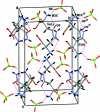dl-Asparaginium perchlorate
- PMID: 21577660
- PMCID: PMC2969914
- DOI: 10.1107/S1600536809033534
dl-Asparaginium perchlorate
Abstract
Two enantiomeric counterparts (l- and d-asparginium cations related by glide planes) are present in the structure of the title compound, C(4)H(9)N(2)O(3) (+)·ClO(4) (-), with a 1:1 cation-anion ratio. The structure is built up from asparginium cations and perchlorate anions. In the crystal, mol-ecules assemble in double layers parallel to (100) through N-H⋯O, O-H⋯O and C-H⋯O hydrogen bonds. In the asparginium layers, hydrogen bonds generate alternating R(2) (2)(8) and R(4) (3)(18) graph-set motifs. Further hydrogen bonds involving the anions and cations result in the formation of a three-dimensional network.
Figures






References
-
- Aarthy, A., Anitha, K., Athimoolam, S., Bahadur, S. A. & Rajaram, R. K. (2005). Acta Cryst. E61, o2042–o2044.
-
- Altomare, A., Cascarano, G., Giacovazzo, C. & Guagliardi, A. (1993). J. Appl. Cryst.26, 343–350.
-
- Anitha, K., Athimoolam, S. & Rajaram, R. K. (2005). Acta Cryst. E61, o1463–o1465.
-
- Bernstein, J., Davis, R. E., Shimoni, L. & Chang, N. (1995). Angew. Chem. Int. Ed. Engl.34, 1555–1573.
LinkOut - more resources
Full Text Sources
